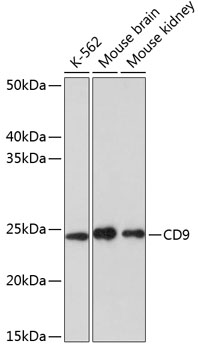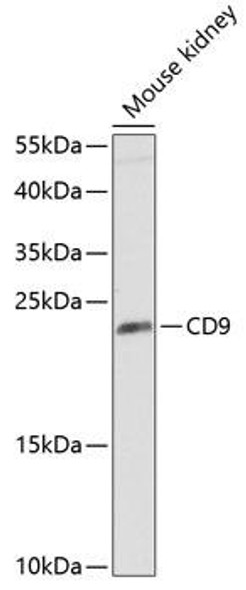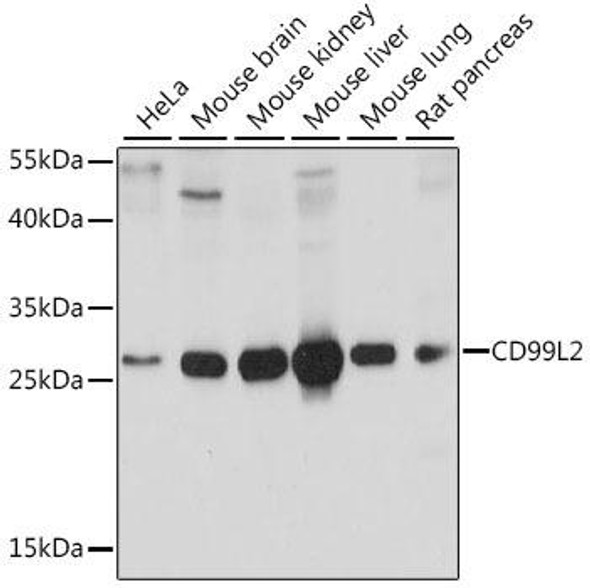Anti-CD9 Antibody (CAB19027)
- SKU:
- CAB19027
- Product type:
- Antibody
- Reactivity:
- Human
- Mouse
- Host Species:
- Rabbit
- Isotype:
- IgG
- Research Area:
- Cell Biology
Frequently bought together:
Description
| Antibody Name: | Anti-CD9 Antibody |
| Antibody SKU: | CAB19027 |
| Antibody Size: | 20uL, 50uL, 100uL |
| Application: | WB IHC |
| Reactivity: | Human, Mouse |
| Host Species: | Rabbit |
| Immunogen: | A synthesized peptide derived from human CD9 |
| Application: | WB IHC |
| Recommended Dilution: | WB 1:500 - 1:2000 IHC 1:50 - 1:200 |
| Reactivity: | Human, Mouse |
| Positive Samples: | K-562, Mouse brain, Mouse kidney |
| Immunogen: | A synthesized peptide derived from human CD9 |
| Purification Method: | Affinity purification |
| Storage Buffer: | Store at -20°C. Avoid freeze / thaw cycles. Buffer: PBS with 0.02% sodium azide, 0.05% BSA, 50% glycerol, pH7.3. |
| Isotype: | IgG |
| Sequence: | Email for sequence |
| Gene ID: | 928 |
| Uniprot: | P21926 |
| Cellular Location: | |
| Calculated MW: | 25kDa |
| Observed MW: | 25kDa |
| Synonyms: | BTCC-1, DRAP-27, MIC3, MRP-1, TSPAN-29, TSPAN29, CD9 |
| Background: | This gene encodes a member of the transmembrane 4 superfamily, also known as the tetraspanin family. Tetraspanins are cell surface glycoproteins with four transmembrane domains that form multimeric complexes with other cell surface proteins. The encoded protein functions in many cellular processes including differentiation, adhesion, and signal transduction, and expression of this gene plays a critical role in the suppression of cancer cell motility and metastasis. [provided by RefSeq, Jan 2011] |
| UniProt Protein Function: | CD9: Involved in platelet activation and aggregation. Regulates paranodal junction formation. Involved in cell adhesion, cell motility and tumor metastasis. Required for sperm-egg fusion. Belongs to the tetraspanin (TM4SF) family. |
| UniProt Protein Details: | Protein type:Cell adhesion; Membrane protein, integral; Membrane protein, multi-pass; Motility/polarity/chemotaxis Chromosomal Location of Human Ortholog: 12p13.31 Cellular Component: extracellular space; focal adhesion; integral to plasma membrane; membrane; plasma membrane; platelet alpha granule membrane Molecular Function:protein binding Biological Process: cell adhesion; cell motility; cell surface receptor linked signal transduction; fusion of sperm to egg plasma membrane; paranodal junction assembly; platelet degranulation; receptor internalization |
| NCBI Summary: | This gene encodes a member of the transmembrane 4 superfamily, also known as the tetraspanin family. Tetraspanins are cell surface glycoproteins with four transmembrane domains that form multimeric complexes with other cell surface proteins. The encoded protein functions in many cellular processes including differentiation, adhesion, and signal transduction, and expression of this gene plays a critical role in the suppression of cancer cell motility and metastasis. [provided by RefSeq, Jan 2011] |
| UniProt Code: | P21926 |
| NCBI GenInfo Identifier: | 231724 |
| NCBI Gene ID: | 928 |
| NCBI Accession: | P21926.4 |
| UniProt Secondary Accession: | P21926,Q5J7W6, Q96ES4, D3DUQ9, |
| UniProt Related Accession: | P21926 |
| Molecular Weight: | |
| NCBI Full Name: | CD9 antigen |
| NCBI Synonym Full Names: | CD9 molecule |
| NCBI Official Symbol: | CD9 |
| NCBI Official Synonym Symbols: | MIC3; MRP-1; BTCC-1; DRAP-27; TSPAN29; TSPAN-29 |
| NCBI Protein Information: | CD9 antigen |
| UniProt Protein Name: | CD9 antigen |
| UniProt Synonym Protein Names: | 5H9 antigen; Cell growth-inhibiting gene 2 protein; Leukocyte antigen MIC3; Motility-related protein; MRP-1; Tetraspanin-29; Tspan-29; p24; CD_antigen: CD9 |
| Protein Family: | CD9 antigen |
| UniProt Gene Name: | CD9 |






